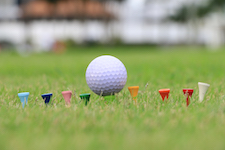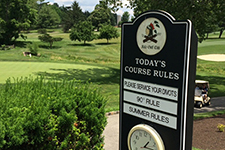HOLE 4:
ETIQUETTE & RULES
Golf has a long history, and many of its traditions, practices, and unspoken rules are not intuitive. Unless you know the etiquette and rules of the game, you may have no idea that you crossed a line. Because we don’t want you to accidentally damage your professional or personal image, in this section you will learn many of the spoken and unspoken rules of golf. Though you may not win awards for your swing, you will attract positive attention when you follow the etiquette and rules of the game.
BASIC GOLF RULES
Introduction
The United States Golf Association (USGA) governs the game of golf around the world and jointly administers the Rules of Golf with the R&A, a group based in St. Andrews, Scotland that supports the sport of golf. There are currently 34 categories of rules broken down into sub-categories that cover topics such as equipment, ball placement, obstructions, hazards, and competitive playing formats. While you are not expected to be versed in every single rule, it's a good idea to be aware of the basics if you find yourself in a friendly competition!
Ten Basic Rules
NUMBER OF CLUBS
To play the game, any combination of clubs are acceptable, but you can’t carry more then 14 clubs in your bag at one time.
WHEN TO USE A GOLF TEE
A golf tee is only allowed when you hit from the tee box area. However, if you're not playing in a competition, it is acceptable for beginners to place the ball on a short tee in the fairway to help get the ball airborne.
WHERE TO PLACE THE TEE
The tee box is set up with two markers that provide a guide as to where you can place your tee. You may place your tee anywhere you like between the tee markers, as long as you are even with, or behind, the markers, up to two club lengths back. Placing your ball and tee any distance in front of the markers towards the hole is not allowed.
PLAY THE BALL WHERE IT LIES
One of the rules a new golfer may accidentally break is picking up her ball (or worse, picking up someone else’s ball) while it’s in play on the course. Unless the ball is out of bounds or lands in an unusual spot where the rule has an exception, you must play your ball exactly where it lies. That means neither you nor any other player may move the ball or pick it up to identify the owner. This is why you commonly see golfers choose different brands or ball colors, or draw marks on their ball to visually identify their ball in the event that two balls land close together.
LANDING IN WATER
When your ball goes into a water hazard, you have two choices as to where to drop another ball and continue your game. You can drop a ball near the place it went into the water, or you can hit again from the original spot. In either case, count a stoke on your scorecard when you drop the ball to continue play.
HITTING OUT OF A SAND TRAP
If you find your ball in a sand trap, you cannot touch the surface of the sand with your club prior to hitting the ball. This rule is commonly referred to as "a player may not ground the club" in the sand (yes, that is a mouthful!). You will notice that golfers will hover their club above the ball before they take a swing. The proper technique to hit out of sand is to strike the sand first with the club to propel the ball successfully out.
KNOCKING ANOTHER PLAYER'S BALL
From time to time, your ball may hit another player's ball at rest in the fairway or on the putting green. While there is no penalty, there is a rule that governs where the balls are replaced. The ball that was struck and displaced is allowed to be placed back in its original spot. The ball that hit the stationary ball is played from where it ends up.
LOOKING FOR A LOST BALL
The rules specify a time limit on how long you can look for a lost ball before you must drop another and continue play. When time is up and you haven't found your ball, you must take a stroke to drop a new ball, which is typically back at the original spot.
PICKING UP A BALL ON THE PUTTING GREEN
It's common practice and allowable for golfers to pick up their ball on the putting surface. However, there is a procedure to properly mark the ball position in order to place it back in the same spot.
To mark a ball properly, stand behind the ball and imagine an invisible line going directly into the hole. Place a ball marker on the ground behind the ball. Only then do the rules allow the ball to be picked up. Use this as an opportunity to brush off sand or debris for a smooth roll towards the hole.
When it’s your turn to putt, place the ball back in the exact spot in front of the marker and proceed to putt. Failure to pick up and remove your ball properly may result in a penalty.
HITTING THE FLAGSTICK WHEN PUTTING
The flagstick helps golfers see where the hole is located. As golfers get closer and putt on the green, the flag is typically pulled by one of the players. Recently the rules of golf have changed so that the flagstick can be left in the hole when you are putting. If the ball hits the flagstick, there is no penalty incurred. In cases where a golfer needs the flag in order to see where to aim, she will ask someone to TEND THE FLAG, meaning another golfer will hold onto the flagstick and pull it out immediately after she strikes the ball.
THE MAXIMUM SCORE YOU CAN POST
For players that have an established handicap, the USGA has a table that indicated the maximum score you can post on a single hole. The higher your handicap, the higher this maximum will be.
For those without a handicap the USGA has updated the rules so that a player may not post a score higher than 5 over par. This is good news for players who are working on their game! For example on a hole that is a par 4, once you have taken 8 shots you can post a 9 on your scorecard and pick up your ball. This rule is intended to help golfers keep a good pace of play.
Complete Set of Rules
For more information we have provided a link to review the official rules of golf.
LINK to the R&A's Guide to Golf Rules








